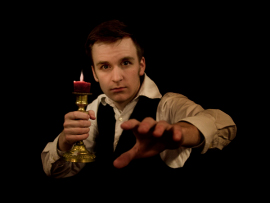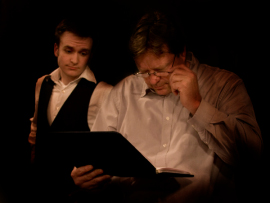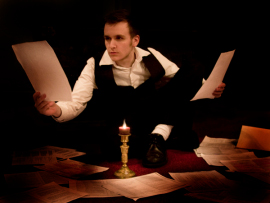 There's an awful lot going on in the Harrison Hilltop Theatre's current presentation of the ghost story The Woman in Black - including two concurrent storylines, a wealth of exposition, a pair of actors taking on multiple roles and perspectives, and sound and lighting effects galore - and it winds up being much too much. But I'm generally happier watching a theatrical production that aims for the stars and doesn't get there than one that doesn't reach at all, so it was still easy to enjoy this wildly ambitious, if ultimately disappointing, presentation; I had just enough fun at Saturday's performance to regret not having more fun.
There's an awful lot going on in the Harrison Hilltop Theatre's current presentation of the ghost story The Woman in Black - including two concurrent storylines, a wealth of exposition, a pair of actors taking on multiple roles and perspectives, and sound and lighting effects galore - and it winds up being much too much. But I'm generally happier watching a theatrical production that aims for the stars and doesn't get there than one that doesn't reach at all, so it was still easy to enjoy this wildly ambitious, if ultimately disappointing, presentation; I had just enough fun at Saturday's performance to regret not having more fun.
Certainly, director Annie Shortridge has you anticipating happy goosebumps before the production even starts, with the pre-show darkness illuminated by only a few colored lights, playing areas draped in white cloth, ominous music in the background, and a more ominous doorway positioned against the rear wall; the setting suggests a Halloween spook house at which you stay seated while the horrors come to you. (Lighting designer Tristan Tapscott and sound designer Chris Walljasper shared scenic-design duties with actor James Bleecker.) And you might find yourself reflexively grinning when the play itself begins, and you sense just how deviously complex Steven Malatratt's adaptation of Susan Hill's novel will likely get.
The Woman in Black finds Englishman Arthur Kipps (Don Hazen) traumatized by a nightmarish incident from his past, and attempting to exorcise his demons through a theatrical take on the event - one that involves a haunted house, a hideous curse, and a spectral woman (in black). He recruits a local actor (Bleecker) to assist him, with the unnamed thespian portraying the younger Kipps, and Kipps himself playing supporting roles. What follows are dual linear narratives, one in which the mysterious tale is reenacted, and one in which its performers comment on the reenactment. (If, during the show, you find yourself confused about who's playing whom, you won't be much helped by the program, which mistakenly identifies Bleecker as Kipps and Hazen as the actor.)
 All of this might make the play sound hopelessly knotty. But the script is actually quite lucid; it's the presentation that's a little knotty, mostly because you feel it trying too hard. There's an impressive amount of visual invention on display here, and Shortridge - with little more than a large trunk on wheels to serve as desks, beds, horse-drawn carriages, and other set pieces - comes through with some spectacularly imaginative staging. (The visualization of Bleecker's travels on three separate trains is so smart you want to applaud.) Too often, though, you feel a sense of overreaching, mostly because, put simply, the Harrison Hilltop venue isn't (yet) equipped to handle the technical demands of this particular play.
All of this might make the play sound hopelessly knotty. But the script is actually quite lucid; it's the presentation that's a little knotty, mostly because you feel it trying too hard. There's an impressive amount of visual invention on display here, and Shortridge - with little more than a large trunk on wheels to serve as desks, beds, horse-drawn carriages, and other set pieces - comes through with some spectacularly imaginative staging. (The visualization of Bleecker's travels on three separate trains is so smart you want to applaud.) Too often, though, you feel a sense of overreaching, mostly because, put simply, the Harrison Hilltop venue isn't (yet) equipped to handle the technical demands of this particular play.
Due to the inherently limited lighting options, the show's toggling between real life and memory is established primarily through the performers' continual turning on and off of the space's house lights via a wall switch, and despite being handled speedily enough, these transitions routinely disrupt the momentum; without benefit of the elegant visual orchestration the show kind of needs (and unfortunately can't have in this venue), the production doesn't flow very gracefully, and is too often a series of stops and starts.
And while the piece is dependent on sound effects, the recordings themselves, I'm sorry to say, don't increase the tension; they more frequently nullify it. The clomping of horses is effective, but the blood-curdling scream sounds more like a faraway yelp, and the voice-over narration is alternately too quiet (most of Act I's climax is lost) or too loud (with every plosive uttered, it sounds like someone is spitting into the microphone). Far more effective is the insistent thump-thump, thump-thump of a heartbeat that's performed live, and is the most giddily nerve-jangling element in the show; you end up wishing far more of the production were presented without the technical "enhancements."
 Yet you stick with The Woman in Black primarily because it is so adventurous, and because of its incredibly committed actors. For those who've long admired Hazen's charming, big-hearted portrayals, the chance to see him in this expansive role is a total pleasure. As always, he exudes kindness and salt-of-the-earth sense, but his smaller, more eccentric turns here also reveal a focused, clever character actor at work, and he's a strong partner to the positively outstanding Bleecker. His scenes as Kipps offer a carefully delineated progression from trepidation to madness, and his routines as the actor are quick-witted, vigorous, and full of much-needed humor; it's the finest of the five stage performances in which I've seen Bleecker in as many months, which is saying a lot. He and Hazen are more than enough reason for a visit, even if they are occasionally undermined by their show's externals; The Woman in Black is a fine reminder that effects are all well and good, but sometimes, especially in a ghost story, simplicity is even better.
Yet you stick with The Woman in Black primarily because it is so adventurous, and because of its incredibly committed actors. For those who've long admired Hazen's charming, big-hearted portrayals, the chance to see him in this expansive role is a total pleasure. As always, he exudes kindness and salt-of-the-earth sense, but his smaller, more eccentric turns here also reveal a focused, clever character actor at work, and he's a strong partner to the positively outstanding Bleecker. His scenes as Kipps offer a carefully delineated progression from trepidation to madness, and his routines as the actor are quick-witted, vigorous, and full of much-needed humor; it's the finest of the five stage performances in which I've seen Bleecker in as many months, which is saying a lot. He and Hazen are more than enough reason for a visit, even if they are occasionally undermined by their show's externals; The Woman in Black is a fine reminder that effects are all well and good, but sometimes, especially in a ghost story, simplicity is even better.
For tickets, call (309)235-1654.










